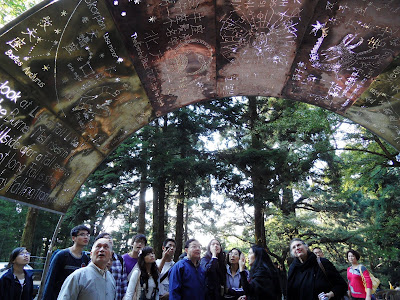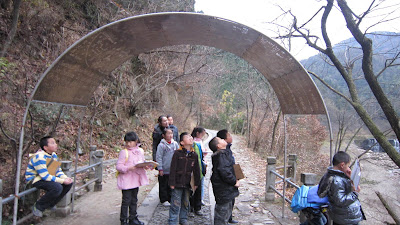 1. Sternenzelt „Poetic Forest“ Internationaler Waldkunstpfad auf dem Mount Lushan, China,Projektdurchführung Ute Ritschel, Kuratorin Symposium: 21. September bis 9. Oktober
1. Sternenzelt „Poetic Forest“ Internationaler Waldkunstpfad auf dem Mount Lushan, China,Projektdurchführung Ute Ritschel, Kuratorin Symposium: 21. September bis 9. Oktober
German artists: Jens Meyer, Roger Rigorth, Barbara Beisinghoff, Joachim Kuhlmann and Waltraud Munz. International artists and speakers: Ping Qiu (China/ Germany) Walter van Broekhuizen, Byon Tak (Korea), Bonggi Park (Korea) and Alec Finlay (Scotland).
Woche des chinesischen Nationalfeiertages: 1. Oktober bis 8. Oktober 2010 In dieser Ferienwoche besuchen rund eine Million Chinesen den Mount Lushan.
World Famous Mountain Konferenz mit Konferenzteilnehmern aus fünf Kontinenten: 11. bis 16. Oktober 2010
Der historische Mount Lushan, der sogenannte „Schöne Berg“ in der Provinz Jiangxi, mit seiner V illenkolonie in Guling vom Ende des 19. Jhd. ist ein ganz besonderer Ort in China. Dort haben sich Europäer, Amerikaner und Chinesen angesiedelt, um in ihren Sommerhäusern das ausgeglichene Klima dieser Bergregion zu genießen. Tschiang Kai Schek und Mao Zedong verbrachten dort ihre Sommer. Ihre Häuser sind zu besichtigen. Auf dem Mount Lushan wurde Pearl S. Buck zu ihrem weltberühmten Roman „Die gute Erde“ inspiriert und Mao wurde durch viele in Stein geritzte Gedichte verewigt. Die Wege und Pfade, die sich um den Mount Lushan winden, sind romantisch mit steilen Abstiegen auf breiten Steinwegen, mit Wasserfällen, kleinen Seen, uralten Bäumen und verwunschenen Tempeln. Die Einladung zum internationalen Waldkunstpfad kam durch die Zusammenarbeit des Geo-Naturparks Bergstraße - Od
illenkolonie in Guling vom Ende des 19. Jhd. ist ein ganz besonderer Ort in China. Dort haben sich Europäer, Amerikaner und Chinesen angesiedelt, um in ihren Sommerhäusern das ausgeglichene Klima dieser Bergregion zu genießen. Tschiang Kai Schek und Mao Zedong verbrachten dort ihre Sommer. Ihre Häuser sind zu besichtigen. Auf dem Mount Lushan wurde Pearl S. Buck zu ihrem weltberühmten Roman „Die gute Erde“ inspiriert und Mao wurde durch viele in Stein geritzte Gedichte verewigt. Die Wege und Pfade, die sich um den Mount Lushan winden, sind romantisch mit steilen Abstiegen auf breiten Steinwegen, mit Wasserfällen, kleinen Seen, uralten Bäumen und verwunschenen Tempeln. Die Einladung zum internationalen Waldkunstpfad kam durch die Zusammenarbeit des Geo-Naturparks Bergstraße - Od enwald im Oktober 2009 mit dem Geopark Mount Lushan zustande. Hessen ist die Partnerregion der Provinz Jiangxi. „Poetic Forest“ wurde auf dem „Pfad des gelben Drachentempels“ verwirklicht. Barbara Beisinghoff dedicates a canopy to Li Bai, 701-762. Overlook at Lushan Fall / Over the burner mist rises in the sunshine, / On the hillside afar, a fall seems to lie. / The 3000-foot-long fall is straight to fly. / Is the Milky Way falling from the sky? The roof of the bridge is of seven perforated copper- and brass-plates under a construction of steel tubes. From the bridge you overlook a waterfall and the Yellow Dragon Pool. The undersid
enwald im Oktober 2009 mit dem Geopark Mount Lushan zustande. Hessen ist die Partnerregion der Provinz Jiangxi. „Poetic Forest“ wurde auf dem „Pfad des gelben Drachentempels“ verwirklicht. Barbara Beisinghoff dedicates a canopy to Li Bai, 701-762. Overlook at Lushan Fall / Over the burner mist rises in the sunshine, / On the hillside afar, a fall seems to lie. / The 3000-foot-long fall is straight to fly. / Is the Milky Way falling from the sky? The roof of the bridge is of seven perforated copper- and brass-plates under a construction of steel tubes. From the bridge you overlook a waterfall and the Yellow Dragon Pool. The undersid e of the canopy appears dark with holes of light and forms a galaxy of stars in the night sky.
e of the canopy appears dark with holes of light and forms a galaxy of stars in the night sky.
 According to Li Bai’s time Barbara Beisinghoff chose the Kitora Kofun Sky Map from the late 7th/ early 8th century as a model for the four plates representing the four seasons and the middle section shows the Dunhuang star map with »asterisms« (clusters of stars), dating from the Tang Dynasty. The star map refers to the Milky Way of Li Bai's poem. This roof does not protect anybody; in contrary it consists of filigree patterns of holes. These patterns "catch the light" and open up the perception to the cycle of time and infinity. Die Bezeichnung "Der Poetische Wald" hat noch eine weitere Bedeutung. Am Mount Lushan befand sich eine Dichterakademie 白鹿洞书院, pinyin: Báilùdòng Shūyuàn, übersetzt White Deer Grotto (Hollow or Cave) Academy. It was located at the foot of Wulou Peak in Lushan. It was one of the Four Great Academies of China.The academy had its beginnings as a place for the pursuit of learning by the Tang Dynasty poet Li Bo, 李渤. Lǐ Bó lived here in retirement. As Li Bo kept a white deer, he was known as the White Deer Teacher and the school premises themselves as the White Deer Grotto. This Li Bo died 831 and should not to be confused with the more famous Tang poet Li Po or Li Bai of the poem about the waterfall. Between the years 937—942, when the area was under the control of the Southern Tang, a school was officially established here under the name "Lushan Guoxue" or "Lu-san Goet-hok" (庐山国学, meaning "Mount Lu National School").
According to Li Bai’s time Barbara Beisinghoff chose the Kitora Kofun Sky Map from the late 7th/ early 8th century as a model for the four plates representing the four seasons and the middle section shows the Dunhuang star map with »asterisms« (clusters of stars), dating from the Tang Dynasty. The star map refers to the Milky Way of Li Bai's poem. This roof does not protect anybody; in contrary it consists of filigree patterns of holes. These patterns "catch the light" and open up the perception to the cycle of time and infinity. Die Bezeichnung "Der Poetische Wald" hat noch eine weitere Bedeutung. Am Mount Lushan befand sich eine Dichterakademie 白鹿洞书院, pinyin: Báilùdòng Shūyuàn, übersetzt White Deer Grotto (Hollow or Cave) Academy. It was located at the foot of Wulou Peak in Lushan. It was one of the Four Great Academies of China.The academy had its beginnings as a place for the pursuit of learning by the Tang Dynasty poet Li Bo, 李渤. Lǐ Bó lived here in retirement. As Li Bo kept a white deer, he was known as the White Deer Teacher and the school premises themselves as the White Deer Grotto. This Li Bo died 831 and should not to be confused with the more famous Tang poet Li Po or Li Bai of the poem about the waterfall. Between the years 937—942, when the area was under the control of the Southern Tang, a school was officially established here under the name "Lushan Guoxue" or "Lu-san Goet-hok" (庐山国学, meaning "Mount Lu National School").
In the early years of the Northern Song dynasty, which began in 960,
the Lushan Guoxue was transformed into an academy, known as the White
Deer Grotto Academy. The academy was the recipient of imperial favour
from the Emperor Taizong (r. 976-997), who bestowed on it books and
awarded official rank to the academy's head. However, it later fell into
disrepair.
 e of the canopy appears dark with holes of light and forms a galaxy of stars in the night sky.
e of the canopy appears dark with holes of light and forms a galaxy of stars in the night sky.In 1179-80, during the Southern Song dynasty, the academy was rebuilt and expanded by Zhu Xi, later to become the most preeminent of the neo-Confucianists. Zhu Xi, who was serving as prefect of Nankang Prefecture (now Nankang City), rebuilt the academy based on the layout of the Temple of Confucius at Qufu. The new academy opened its doors to students and scholars in 1180. It was involved in instruction, the collection and preservation of books, religious sacrifices, the development of curricula, and lectures by famous scholars, including such notable names as Lu Jiuyuan, Lü Zuqian, and later Wang Yangming. The academy continued to flourish for eight centuries. The rules of the Academy as set down by Zhu Xi had a profound and lasting influence on the subsequent development of Confucianism.
Nach dem 1. Sternenzelt auf dem Mount Lushan in China, dem 2. in Darmstadt, dem 3. in Diemelstadt- Rhoden entstand das 4. Sternenzelt für Forest Art Chengdu im November 2015 in Dunjiangyan in Sezuan
Barbara Beisinghoff (Germany 德国)
Celestial Canopy 天国苍穹
Walking and pausing under the Celestial Canopy we see day light from above, through the holes of the patterns we envisage star clusters of the night sky. Had star maps been a guide for the merchants on the Tea and Horse Route?
We are inspired by Shu embroidery, by the Sun Bird of Jinsha and the bronze trees of Sanxingdui. The Celestial Canopy is a communicative project with local helpers and students.
The light of the sky passes through the perforated roof. Seven copper plates use light patterns to represent our cosmos: 1. Water, 2. Earth and plants, 3. Sun and seasons, 4. Light and inspiration, 5. Stars and dreams, 6. Humans and energy and 7. Trails and environment.
Immateriality turns into enlightenment. The Canopy is dedicated to the Celestial Master and the people of Dunjiangyan.





